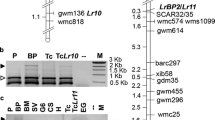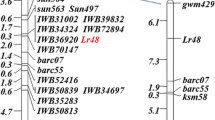Abstract
The objective of this study was to identify molecular markers linked to the wheat leaf rust resistance gene Lr24 derived from Agropyron elongatum (3DL/3Ag translocation). Two near isogenic lines (NILs), ‘Arina’ and Lr24/7 * “Arina”, were screened for polymorphism at the DNA level with 115 RFLP probes. Twenty-one of these probes map to the homoeologous group 3. In addition, 360 RAPD primers were tested on the NILs. Six RFLP probes showed polymorphism between the NILs, and 11 RAPD primers detected one additional band in the resistant NIL. The genetic linkage of the polymorphic markers with Lr24 was tested on a segregating F2 population (150 plants) derived from a cross between the leaf rust resistant Lr24/7 * “Arina” and the susceptible spelt (Triticum spelta) variety ‘Oberkulmer’. All 6 RFLP markers were completely linked to Lr24: one was inherited as a codominant marker (PSR1205), one was in coupling phase (PSR1203) and 4 were in repulsion phase (PSR388, PSR904, PSR931, PSR1067) with Lr24. The localization of these probes on chromosome 3D was confirmed by nulli-tetrasomic analysis. Distorted genotypic segregation was found for the Codominant RFLP marker PSR1205. This distortion can be explained by the occurrence of hemizygous plants. One of the 11 RAPD markers (OPJ-09) also showed complete linkage to theLr24 resistance gene. The polymorphic RAPD fragment was cloned and sequenced. Specific primers were synthesized, and they produced an amplification product only in the resistant plants. This specific marker allows a reliable and rapid screening of a large number of genotypes in practical breeding. Analysis of 6 additional lines containing Lr24 revealed that 3 lines have a smaller chromosomal segment of A. elongatum than lines derived from ‘Agent’, a commonly used gene donor for the Lr24 resistance gene.
Similar content being viewed by others
References
Baum M, Lagudah ES, Appels R (1992) Wide crosses in cereals. Annu Rev Plant Physiol Plant Mol Biol 43:117–143
Browder LE (1973) Probable genotype of some Triticum aestivum ‘Agent’ derivatives for reaction to Puccinia recondita f. sp. tritici. Crop Sci 13:203–206
Devos KM, Gale MD (1992) The use of random amplified polymorphic DNA markers in wheat. Theor Appl Genet 84:567–572
Devos KM, Gale MD (1993) Extended genetic maps of the homoeologous group 3 chromosomes of wheat rye and barley. Theor Appl Genet 85:649–652
Devos KM, Atkinson MD, Chinoy CN, Liu CJ, Gale MD (1992) RFLP-based genetic map of the homoeologous group 3 chromosomes of wheat and rye. Theor Appl Genet 83:931–939
Devos KM, Millan T, Gale MD (1993) Comparative RFLP maps of the homoeologous group-2 chromosomes of wheat, rye and barley. Theor Appl Genet 85:784–792
Graner A, Siedler H, Jahoor A, Herrmann RG, Wenzel G (1990) Assessment of the degree and type of restriction fragment length polymorphism in barley (Hordeum vulgare). Theor Appl Genet 80:826–832
Hartl L, Weiss H, Zeller FJ, Jahoor A (1993) Use of RFLP markers for the identification of alleles of the Pm3 locus conferring powdery mildew resistance in wheat (Triticum aestivum L.). Theor Appl Genet 86:959–963
Knott DR (1989) The wheat rusts — breeding for resistance. Monographs on theoretical and applied genetics 12. Springer, Berlin Heidelberg New York
Kolmer JA (1993) Physiologic specialization of Puccinia recondita f. sp. tritici in Canada in 1991. Can J Plant Pathol 15:34–36
Liu YG, Mori N, Tsunewaki K (1990) Restriction fragment length polymorphism (RFLP) analysis in wheat. I. Genomic DNA library construction and RFLP analysis in common wheat. Jpn J Genet 65:367–380
Long DL, Roelfs AP, Leonard KJ, Roberts JJ (1993) Virulence and diversity of Puccinia recondita f. sp. tritici in the United States in 1991. Plant Dis 77:786–791
Martens JW, Dyck PL (1988) Occurrence and virulence of Puccinia recondita in Canada in 1986. Can J Plant Pathol 10:268–272
McIntosh RA, Dyck PL, Green GJ (1976) Inheritance of leaf rust and stem rust resistances in wheat cultivars ‘Agent’ and ‘Agatha’. Aust J Agric Res 28:37–45
Olson M, Hood L, Cantor CH, Botstein D (1989) A common language for physical mapping of the human genome. Science 24:1434–1435
Penner GA, Chong J, Levesque-Lemay M, Molnar SJ, Fedak G (1993) Identification of a RAPD marker linked to the oat stem rust gene Pg3. Theor Appl Genet 85:702–705
Roelfs AP, Singh RP, Saari EE (1992) Rust diseases of wheat: concepts and methods of disease management. CIMMYT, Mexico, D.F.
Ronald PC, Albano B, Tabien R, Abenes L, Wu KS, McCouch S, Tanksley SD (1992) Genetic and physical analysis of the rice bacterial blight disease resistance locus, Xa21. Mol Gen Genet 236:113–120
Sanger F, Nicklen S, Coulson AR (1977) DNA sequencing with chain terminating inhibitors. Proc Natl Acad Sci USA 74:5463–5467
Schachermayr G, Siedler H, Gale MD, Winzeler H, Winzeler M, Keller B (1994) Identification and localization of molecular markers linked to the Lr9 leaf rust resistance gene of wheat. Theor Appl Genet 88:110–115
Schüller C, Backes G, Fischbeck G, Jahoor A (1992) RFLP markers to identify the alleles on the Mla locus conferring powdery mildew resistance in barley. Theor Appl Genet 84:330–338
Sears ER (1966) Chromosome mapping with the aid of telocentrics. In: MacKey J (ed) Proc 2nd Int Wheat Genet Symp. Hereditas Suppl 2, Lund, pp 370–381
Sears ER (1973) Agropyron-wheat transfers induced by homoeologous pairing. In: Sears ER, Sears LMS (eds) Proc 4th Wheat Genet Symp. University of Missouri, Columbia, Mo., pp 191–199
Siedler H, Messmer MM, Schachermayr GM, Winzeler H, Winzeler M, Keller B (1994) Genetic diversity in European wheat and spelt breeding material based on RFLP data. Theor Appl Genet 88:994–1003
Siharulidze Z, Naskidashville G, Smirnova LA (1993) Virulence structure of the wheat leaf rust population in Georgia during 1987–1991. Cereal Rusts Powdery Mildew Bull 21:35–40
Smith EL, Schlehuber AM, Young HC, Edwards LH (1968) Registration of ‘Agent’ wheat. Crop Sci 8:511–512
Tingey S, del Tufo JP (1993) Genetic analysis with random amplified polymorphic DNA markers. Plant Physiol 101:349–352
von Kröcher C, Bartels G, Fehrmann H (1992) Studies on the physiological specialization of leaf rust in wheat (Puccinia recondita Rob. ex Desm. f. sp. tritici Eriks.& Henn.). J Plant Dis Prot 99:137–144
Waugh R, Powell W (1992) Using RAPD markers for crop improvement. Trends Biotechnol 10:186–191
Williams GK, Kubelik AR, Kenneth JL, Rafalski A, Scott VT (1990) DNA polymorphism amplified by arbitrary primers are useful as genetic markers. Nucleic Acids Res 18:6531–6535
Author information
Authors and Affiliations
Additional information
Communicated by G. Wenzel
Rights and permissions
About this article
Cite this article
Schachermayr, G.M., Messmer, M.M., Feuillet, C. et al. Identification of molecular markers linked to the Agropyron elongatum-derived leaf rust resistance gene Lr24 in wheat. Theoret. Appl. Genetics 90, 982–990 (1995). https://doi.org/10.1007/BF00222911
Received:
Accepted:
Issue Date:
DOI: https://doi.org/10.1007/BF00222911




